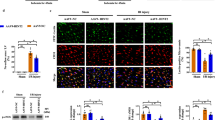Abstract
Free fatty acids (FFA)-induced proliferation and apoptosis was studied in human umbilical vein endothelial cells (HUVECs). A recombinant adenovirus containing a RNAi cassette targeting the GSK-3β gene was produced and its silencing effect on GSK-3β gene was detected by Western blot analysis and immunohistochemistry assay in HUVECs. The effect of the RNAi on the protein level of β-catenin was explored by transfecting the RNAi adenovirus to inhibit the expression of GSK-3β protein. The subsequent effect on the Wnt/GSK-3β/β-catenin signal pathway and on proliferation and apoptosis of HUVECs cultured with FFAs, was analyzed by BrdU assay, Annexin V-FITC/PI Apoptosis Detection Kit, and 4′,6-diamidino-2- phenylindole(DAPI) to explore the possible connection between the signaling pathway and FFA-induced proliferation and apoptosis. The Western blot results showed that the expression of GSK-3β protein in HUVECs could be inhibited efficiently by the RNAi adenovirus, and that the protein level of β-catenin was increased by RNAi adenovirus transfection. The results of the BrdU assay suggested that knockdown of GSK-3β with the RNAi adenovirus may stimulate the proliferation of HUVECs. Apoptosis was observed in HUVECs exposed to FFAs (0.75 mmol/L) for 72 h, and this effect could be partly reversed when interfering with the RNAi adenovirus. It may be concluded that the RNAi adenovirus specific to GSK-3β may partly protect HUVECs from apoptosis induced by FFAs, probably through the up-regulation of the Wnt/β-catenin signal pathway.






Similar content being viewed by others
References
Ho FM, Lin WW, Chen BC et al (2006) High glucose-induced apoptosis in human vascular endothelial cells is mediated through NF-kappaB and c-Jun NH2-terminal kinase pathway and prevented by PI3 K/Akt/eNOS pathway. Cell Signal 18(3):391–399
Ho FM, Liu SH, Liau CS et al (2000) High glucose–induced apoptosis in human endothelial cells is mediated by sequential activations of c-Jun NH2-terminal kinase and caspase-3. Circulation 101:2618–2624
Miho N, Ishida T, Kuwaba N et al (2005) Role of the JNK pathway in thrombin-induced ICAM-1 expression in endothelial cells. Cardiovasc Res 68(2):289–298
Carsten S, Henrike M, Edward R et al (2005) Glycogen-synthase K-inase3β/β-catenin axis promotes angiogenesis through activation of vascular endothelial growth factor signaling in endothelial cells. Circ Res 96:308–318
Yoshihiro T, Tomohiro O, Naoko K et al (2005) Developmental regulation of Wnt/ß-catenin signals is required for growth plate assembly, cartilage integrity, and endochondral ossification. J Biol Chem 280(19):19185–19195
Zhang F, Cheng J, Hackett NR (2004) Adenovirus E4 gene promotes selective endothelial cell survival and angiogenesis via activation of the vascular endothelial-cadherin/Akt signaling pathway. J Biol Chem 279(12):11760–11766
Choi SE, Kang Y, Jang HJ et al (2007) Involvement of glycogen synthase kinase-3beta in palmitate-induced human umbilical vein endothelial cell apoptosis. J Vasc Res 44(5):365–374 Epub 2007 May 4
Schaeffer G, Frank SL, Spitaler MM et al (2003) Intercellular signalling within vascular cells under high D-glucose involves free radical-triggered tyrosine kinase activation. Diabetologia 46:773–783
Artwohl M, Roden M, Waldhausl W et al (2004) Free fatty acids trigger apoptosi and inhibit cell cycle progression in human vascular endothelial cells. FASEB J 18(1):146–148
Hanai J, Dhanaba M, Karumanchi SA (2002) Endostatin causes G1 arrest of endothelial cells through inhibition. J Biol Chem 277(19):16464–16469
Liu Z, Hbener JF (2008) Glucagon-like peptide-1 activation of TCF7L2-dependent Wnt signaling enhances pancreatic beta-cell proliferation. J Biol Chem 283(13):8723–8735
Chen H, Yang S, Yang Z et al (2007) Inhibition of GSK-3beta decreases NF-kappaB-dependent gene expression and impairs the rat liver regeneration. J Biochem Cell 102(5):1281–1289
Sheu ML, Ho FM, Yang RS et al (2005) High glucose induces human endothelial cell apoptosis through a phosphoinositide-3-kinase-regulated cyclooxygenase-2 pathway. Arterioscler Thromb Vasc Biol 25(3):539–545
Nakagami H, Morishita R, Yamamoto K et al (2001) Phosphorylation of p38 mitogen-activated protein kinase downstream of bax-caspase-3 pathway leads to cell death induced by high D-glucose in human endothelial cells. Diabetes 50:1472–1481
Acknowledgments
This study was supported by Grant C071002 and 2009Y0011 for natural science foundation from Fujian province of China and grant from the Ministry of Health of the People’s Republic of China (WKJ 2005-2-021). We thank the members of Department of Molecular Medicine Research Center lab of Fujian Medical University, specifically Drs Lin.
Disclosure
The authors disclose this apparent conflict.
Author information
Authors and Affiliations
Corresponding author
Additional information
The authors Penli Zhu, Gang Chen, Tingting You, Jin Yao, and Qiqin Jiang contributed equally to this work.
Rights and permissions
About this article
Cite this article
Zhu, P., Chen, G., You, T. et al. High FFA-induced proliferation and apoptosis in human umbilical vein endothelial cell partly through Wnt/β-catenin signal pathway. Mol Cell Biochem 338, 123–131 (2010). https://doi.org/10.1007/s11010-009-0345-5
Received:
Accepted:
Published:
Issue Date:
DOI: https://doi.org/10.1007/s11010-009-0345-5




